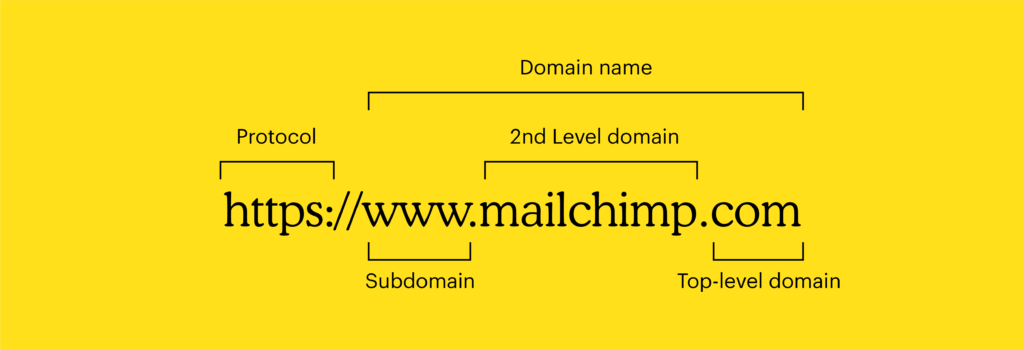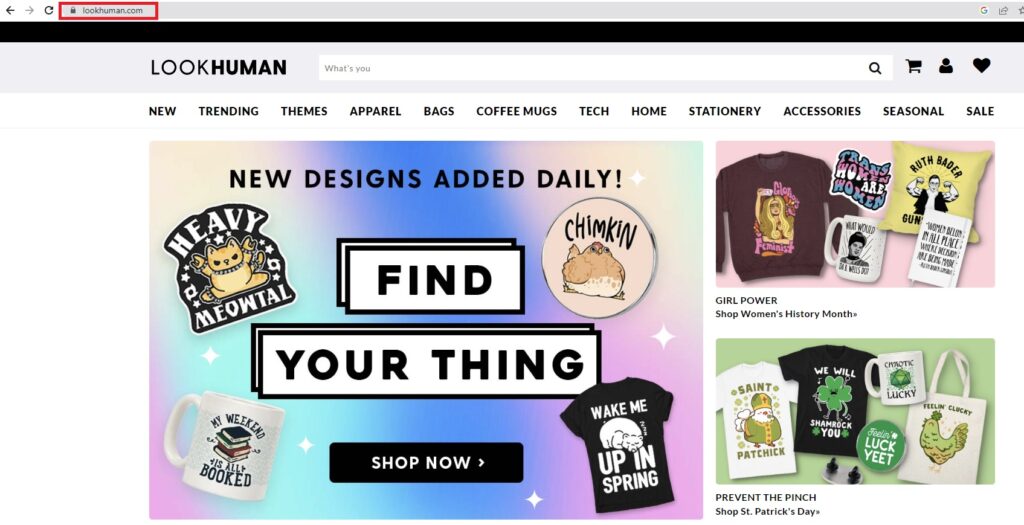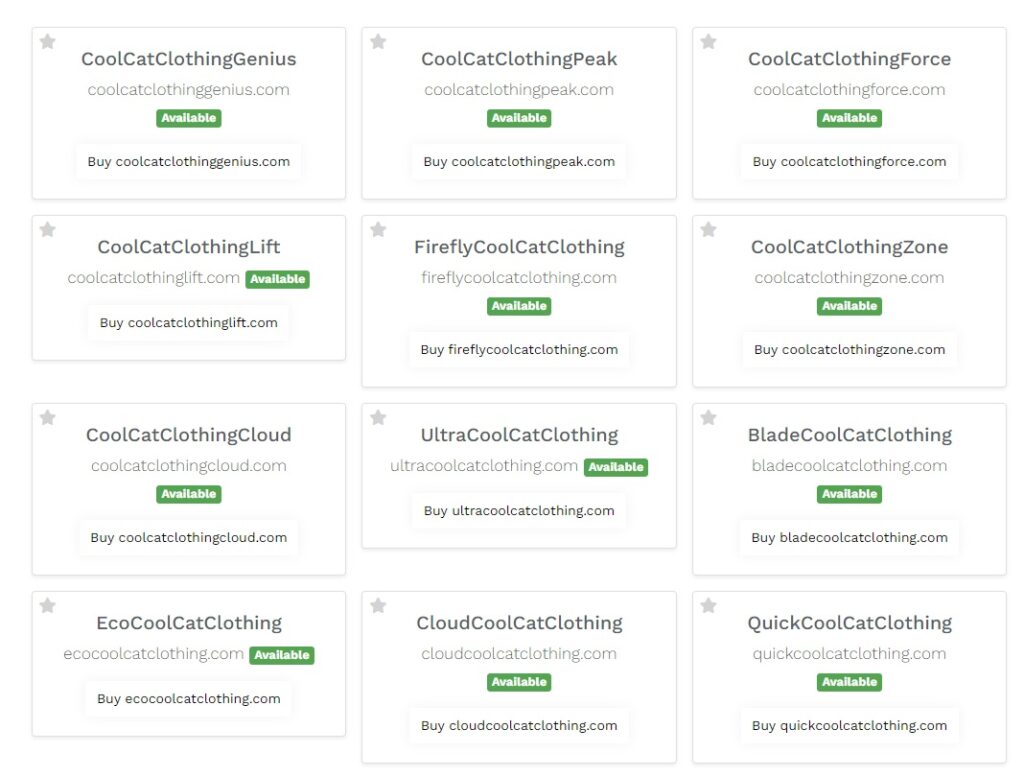What’s in a name? Quite a lot, actually.
No doubt you’ve spent time and effort choosing the right name for your eCommerce business to accurately reflect your brand and products. Now, you need a domain name that does the same thing and brings people to your website.
But the more businesses that register domain names, the more challenging it is to find one that’s (a) available and (b) matches your brand.
In this post, we’ll look at:
- What a domain name is
- Why it’s important to choose the right one
- What to do if your preferred name is unavailable
- How to choose a domain name that reflects your eCommerce brand
Let’s get started.
What Is a Domain Name?
Simply put, a domain name is an original address that is used to access a website or online store. However, it is a little bit more technical than that.
Every website has a unique address assigned to it, which enables it to communicate with a computer network. This is the IP (internet protocol) address, and it’s represented as a string of numbers, such as 12.345.6789.
Of course, you can’t expect people to remember this, so an alphabetic domain name like www.storeya.com is used instead.
Domain names are split into two parts:
- Second-level domain (SLD). The SLD is the part that comes after “www” and is usually the name of your eCommerce brand or product.
- Top-level domain (TLD). Also known as a domain extension, the TLD is the bit that comes after the dot.
There are several types of TLD.
ccTLDs (country-code top-level domains), for instance, denote where you’re based or which country you’re targeting — such as .uk or .us. While gTLDs (generic top-level domains) are extensions like .com, .org, or .gov. that are, like the name suggests, more generic.
More recently, gTLDs have expanded to allow you to use descriptive words, such as .store or .news, or geographic TLDs that are specific to a certain region, such as .nyc or .london.
Here is a quick look at the most popular domain extensions.
[Source: Quickmedia]
Tip: We should point out that your domain name isn’t the same as your URL (unique resource locator). A URL is a complete web address that can direct visitors to a specific page on a site; the domain name is just one part of it.
[Source: Mailchimp]
Why Is It Important to Choose the Right Domain Name?
Your domain name is a crucial part of your brand’s identity. It’s how visitors and potential customers will find you online, and it’s often your first chance to make a great impression.
A good domain name can also help you to:
- Drive awareness and attract new potential shoppers
- Communicate what you do and sell, adding credibility, trust, and professionalism
- Push store brand visibility and recognition
- Build your brand identity
All of which help get clicks (and eyes) to your store and products.
Although the name of your company is an obvious choice, you may want to go for something more unique.
In eCommerce, in particular, there’s an increasing amount of competition and lots of sites selling similar products. Therefore, you need to stand out from the crowd (plus, a more generic name may have already been snapped up).
Unless, of course, your store brand name is unique enough to stand out, like the folks at LookHUMAN.
What If My Preferred Name Is Already Taken?
Unless you have a very unique brand name, it’s likely someone has already bagged the one you want (especially if you were planning to use the hugely popular .com extension).
Therefore, before you get too excited about choosing a domain name, you need to check if it hasn’t been registered by somebody else.
If you’re really keen to use your exact name despite its unavailability, there are a few options.
Firstly, you could play around with the name of your business by amending a word or adding a hyphen or number. If your business is called Cool Cat Clothing, for example, you could style it as coolcatclothes.com, cool-cat-clothing.com, or coolcatclothing21.com.
Side note: If you include a number, make sure it is relevant — perhaps the year you were founded or the street number of your HQ.
The problem with the domain variants above is that they’re not as easy to search.
People are more likely to type the address incorrectly or not recognize the brand, and then you’ll miss out on the opportunity to drive traffic to your store. Mobile users, especially, will have to switch from letters to special characters on their keyboards to type the domain name.
Another option is to consider buying your preferred domain name from whoever currently owns it. You can check who owns a domain name with ICANN Lookup. However, the expense could be too high.
What Is ICANN?
The ICANN (Internet Corporation for Assigned Names and Numbers) is a non-profit organization responsible for allocating IP address space and managing domain names worldwide. Domain name registrars like OnlyDomains are accredited by this body.
Ultimately, none of these are ideal solutions, so you may want to get a little more creative.
How To Choose a Domain Name
The bottom line is that you need a unique domain name that inspires curiosity and makes people want to visit your site, while memorable names help boost brand awareness and discoverability.
But it’s probably best not to go too trendy or niche, as you’ll want to keep this name for a long time. The name should also be easy for people to look up, so keeping it short and catchy is essential.
Also, adding eCommerce SEO keywords to the mix will help you get indexed by search engines, improving your site’s rankings in SERPs.
If you’re on a tight budget, you could just piggyback on the name of your web hosting provider — such as in yourbrand.hostingplatform.com — but this won’t offer much credibility. Customers may wonder why a successful business doesn’t have its own domain name.
Plus, if you don’t own the domain, you’d need a new URL if you wanted to switch hosting providers in the future.
So, what to do?
Here are our top ways you can find and then narrow down your choices for a domain name that reflects your eCommerce brand.
1. Brainstorm Outside of the Box
The first thing you need to do when deciding on a domain name is to start thinking outside the box. This is particularly important if your brand name is lengthy or unwieldy.
In this case, you will want to adapt it so that people can easily remember and search for it. Plus, Google’s algorithms prefer shorter domain names.
Therefore, the humble brainstorming session can be powerful. You will want to think about the following:
- What’s your main product?
- What sort of customers are you targeting?
- What are the benefits of your products?
- Which domain extension best suits your brand?
2. Factor In Your Keywords
It’s a good idea to include SEO keywords in your domain name.
If you’re planning to sell a specific type of clothing, you could use that keyword in your domain name. To use our previous example of Cool Cat Clothing, let’s say your main product is flannel shirts. You could use coolcatflannels.com or even bestflannels.online if you wanted to own the keyword.
In other words, you can try this formula:
[brand name] + [broad keyword] = [domain name]
Here’s an example from Shopify of a store, Verve Coffee Roasters, who did just that.
[Source: Shopify]
Bonus Content: Best Alternative to WordStream: Leading PPC Management Software and Keyword Research Tools
3. Get Creative with Extensions
As we mentioned earlier, you have a choice of extensions, or TLDs, for your domain name.
If you’re based in New Zealand, for instance, it may seem like a no-brainer to buy a co.nz domain. However, you don’t necessarily have to reside in a particular country to use its ccTLD in your domain name. But remember to first check for any local-presence requirements or other restrictions.
[Source: Fit Small Business]
If the .com version is unavailable, you could use one of the new top-level domains instead of compromising on the name of your business.
There are more than 1,000 gTLDs available. This gives you the chance to use an eCommerce-specific extension, such as .store, .shop, .market, or .online. It immediately tells people that you’re selling something.
Going back to our previous example, Cool Cat Clothing Store, you could use coolcatclothing.store, which is shorter than using the full name, plus a different extension. Or, if you’ve set up your eCommerce store to integrate with Shopify, you could go with coolcatshopify.store.
The bottom line is that you can use an extension that forms part of your brand name. Here are some of the top ones from last year.
[Source: Statista]
4. Try a Name Generator Tool
Name generator tools can offer you another level of brainstorming. While some domain registrars offer this service, you can also use popular third-party services such as Namify, Name Station, and Namechk.
[Source: Namechk]
Name generator tools typically ask you to enter a few keywords about your business before coming up with a range of options.
Depending on which tool you use, you may be able to choose the number of words you want or where the keyword is placed. But be careful — your domain name needs to be memorable and easy to search, as well as easy to pronounce in a TV or radio commercial or for your word-of-mouth marketing.
5. Consider Choosing Multiple Domain Names
You don’t have to stop at just one domain name. Some companies register multiple domains to serve a particular purpose, such as targeting a specific need or market. This is what Amazon does with kindle.store and alexa.online, both of which redirect from the main site.
So, if your store sells jeans and boots as well as flannels, you could have coolcatclothing.online as your main site, plus coolcatjeans.store and coolcatboots.store.
Customers can then find exactly what they want, including when they search for “Cool Cat jeans.” You can monitor customer intent and increase traffic to help scale your online clothing store.
You might do this for a specific marketing campaign, with a dedicated domain name for an offer or promotion. It’s more user-friendly than adding the information to the end of an existing URL, and works as an eCommerce marketing strategy alongside methods like Google Customer Match.
Bonus Content: How To Maximize Sales with Google Ads for eCommerce [2023]
It’s also possible to have more than one country-specific or geographic TLD in order to personalize the experience for customers in different regions.
For instance, you could use coolcatclothing.oregon if that’s where you’re based, and coolcat.co.uk for your UK customers.
Other reasons for registering multiple domains include:
- A recent change to your company name (keep the old domain but add a new one, and redirect visitors there)
- To secure several variations of your name so that so-called cybersquatters can’t buy them all up with the intention of selling them to you at inflated prices
Tip: Registering Your Chosen Name
Once you’ve come up with a name and verified that it’s within your budget, and available, you need to register it before someone beats you to it!
Look for a legitimate domain name registrar on the ICANN database and choose one with a wide variety of extensions. Some domain name vendors also sell web hosting and SSL certificates.
Be sure to take note of the registration period. Domain name registration typically lasts between one and 10 years, so write down the expiration date to ensure you don’t lose the name.
Wrap Up
The right domain name plays a key part in capturing customers’ attention and building their trust.
Make sure the name is short and easy to type, as well as catchy and memorable. Consider including relevant keywords, and be creative with extensions that tell your story or target a specific audience. Finally, register your domain name as soon as possible, and enjoy the benefits of extra site traffic and customer confidence.

Daniel is our in-house SEO guru in OnlyDomains, leading web hosting company based in sunny Napier, New Zealand that helps entrepreneurs and business owners achieve online branding success with OnlyDomains .ai registrations. He has been an SEO expert for 15 years, and still enjoys helping, creating engaging websites and interesting content. If not at the computer, he is mostly outside in nature with the family.
Recommended articles
 Facebook Ads for eCommerce: 16 Strategies, Examples & Tips
Facebook Ads for eCommerce: 16 Strategies, Examples & Tips
 How to Build a Winning eCommerce Ads Strategy
How to Build a Winning eCommerce Ads Strategy
 Google Ads for eCommerce: Everything You Need to Know
Google Ads for eCommerce: Everything You Need to Know
 10X Your Traffic with PPC Management Software
10X Your Traffic with PPC Management Software
Comments
Powered by Facebook Comments









